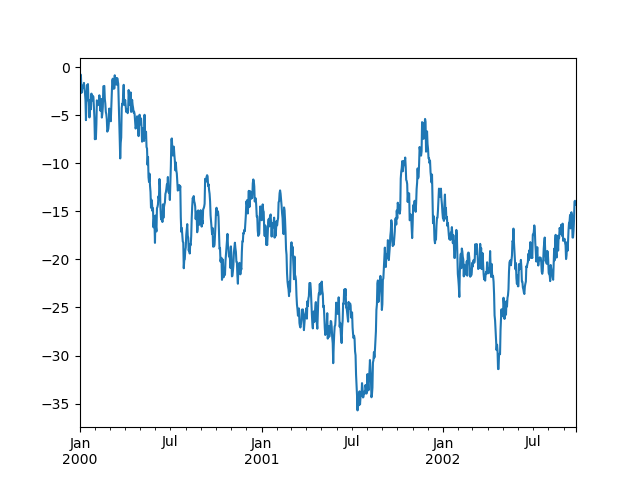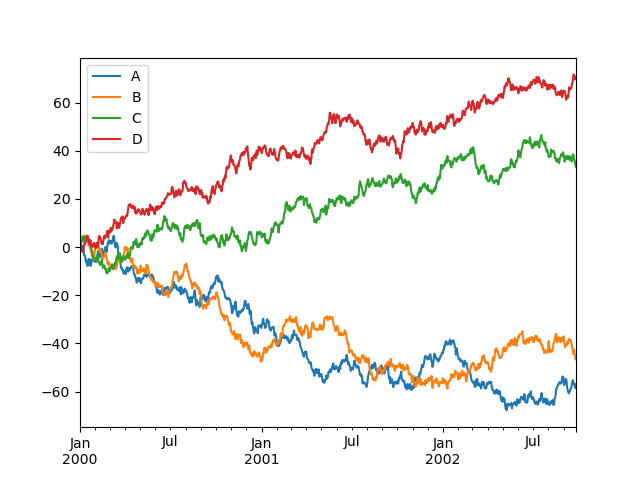Pandas 数据处理(下)
来源:互联网 发布:用手机怎么改淘宝好 编辑:程序博客网 时间:2024/05/21 10:59
Pandas 数据处理(下)
数值运算
统计
运算通常会排除缺省项
求平均值:
df.mean()输出:
A -0.004474B -0.383981C -0.687758D 5.000000F 3.000000dtype: float64求指定轴上的平均值
df.mean(1)输出:
2013-01-01 0.8727352013-01-02 1.4316212013-01-03 0.7077312013-01-04 1.3950422013-01-05 1.8836562013-01-06 1.592306Freq: D, dtype: float64不同维度的 pandas 对象也可以做运算,它会自动进行对应,shift 用来做对齐操作。
s = pd.Series([1,3,5,np.nan,6,8], index=dates).shift(2)s输出:
2013-01-01 NaN2013-01-02 NaN2013-01-03 12013-01-04 32013-01-05 52013-01-06 NaNFreq: D, dtype: float64对不同维度的 pandas 对象进行减法操作:
df.sub(s, axis='index')输出:
A B C D F2013-01-01 NaN NaN NaN NaN NaN2013-01-02 NaN NaN NaN NaN NaN2013-01-03 -1.861849 -3.104569 -1.494929 4 12013-01-04 -2.278445 -3.706771 -4.039575 2 02013-01-05 -5.424972 -4.432980 -4.723768 0 -12013-01-06 NaN NaN NaN NaN NaN函数应用
对数据应用 numpy 函数:
df.apply(np.cumsum) #累加输出:
A B C D F2013-01-01 0.000000 0.000000 -1.509059 5 NaN2013-01-02 1.212112 -0.173215 -1.389850 10 12013-01-03 0.350263 -2.277784 -1.884779 15 32013-01-04 1.071818 -2.984555 -2.924354 20 62013-01-05 0.646846 -2.417535 -2.648122 25 102013-01-06 -0.026844 -2.303886 -4.126549 30 15应用自定义函数:
df.apply(lambda x: x.max() - x.min())输出:
A 2.073961B 2.671590C 1.785291D 0.000000F 4.000000dtype: float64直方图
对不同值的数量进行统计
s = pd.Series(np.random.randint(0, 7, size=10))s输出:
0 41 22 13 24 65 46 47 68 49 4dtype: int32输入:
s.value_counts()输出:
4 56 22 21 1dtype: int64String Methods字符处理
s = pd.Series(['A', 'B', 'C', 'Aaba', 'Baca', np.nan, 'CABA', 'dog', 'cat'])s.str.lower()输出:
0 a1 b2 c3 aaba4 baca5 NaN6 caba7 dog8 catdtype: object合并
Concat
使用 concat() 连接 pandas 对象:
df = pd.DataFrame(np.random.randn(10, 4))df输出:
0 1 2 30 -0.548702 1.467327 -1.015962 -0.4830751 1.637550 -1.217659 -0.291519 -1.7455052 -0.263952 0.991460 -0.919069 0.2660463 -0.709661 1.669052 1.037882 -1.7057754 -0.919854 -0.042379 1.247642 -0.0099205 0.290213 0.495767 0.362949 1.5481066 -1.131345 -0.089329 0.337863 -0.9458677 -0.932132 1.956030 0.017587 -0.0166928 -0.575247 0.254161 -1.143704 0.2158979 1.193555 -0.077118 -0.408530 -0.862495切片
pieces = [df[:3], df[3:7], df[7:]]pd.concat(pieces)输出:
0 1 2 30 -0.548702 1.467327 -1.015962 -0.4830751 1.637550 -1.217659 -0.291519 -1.7455052 -0.263952 0.991460 -0.919069 0.2660463 -0.709661 1.669052 1.037882 -1.7057754 -0.919854 -0.042379 1.247642 -0.0099205 0.290213 0.495767 0.362949 1.5481066 -1.131345 -0.089329 0.337863 -0.9458677 -0.932132 1.956030 0.017587 -0.0166928 -0.575247 0.254161 -1.143704 0.2158979 1.193555 -0.077118 -0.408530 -0.862495Join
SQL 风格的合并
left = pd.DataFrame({'key': ['foo', 'foo'], 'lval': [1, 2]})right = pd.DataFrame({'key': ['foo', 'foo'], 'rval': [4, 5]})输入:
left输出:
key lval0 foo 11 foo 2输入:
right输出:
key rval0 foo 41 foo 5输入:
pd.merge(left, right, on=’key’)
输出:
key lval rval0 foo 1 41 foo 1 52 foo 2 43 foo 2 5追加
在 dataframe 数据后追加行
df = pd.DataFrame(np.random.randn(8, 4), columns=['A','B','C','D'])df输出:
A B C D0 1.346061 1.511763 1.627081 -0.9905821 -0.441652 1.211526 0.268520 0.0245802 -1.577585 0.396823 -0.105381 -0.5325323 1.453749 1.208843 -0.080952 -0.2646104 -0.727965 -0.589346 0.339969 -0.6932055 -0.339355 0.593616 0.884345 1.5914316 0.141809 0.220390 0.435589 0.1924517 -0.096701 0.803351 1.715071 -0.708758输入:
s = df.iloc[3]df.append(s, ignore_index=True)输出:
A B C D0 1.346061 1.511763 1.627081 -0.9905821 -0.441652 1.211526 0.268520 0.0245802 -1.577585 0.396823 -0.105381 -0.5325323 1.453749 1.208843 -0.080952 -0.2646104 -0.727965 -0.589346 0.339969 -0.6932055 -0.339355 0.593616 0.884345 1.5914316 0.141809 0.220390 0.435589 0.1924517 -0.096701 0.803351 1.715071 -0.7087588 1.453749 1.208843 -0.080952 -0.264610分组
分组常常意味着可能包含以下的几种的操作中一个或多个
- 依据一些标准分离数据
- 对组单独地应用函数
- 将结果合并到一个数据结构中
输入:
df = pd.DataFrame({'A' : ['foo', 'bar', 'foo', 'bar', 'foo', 'bar', 'foo', 'foo'], 'B' : ['one', 'one', 'two', 'three', 'two', 'two', 'one', 'three'], 'C' : np.random.randn(8), 'D' : np.random.randn(8)})df输出:
A B C D0 foo one -1.202872 -0.0552241 bar one -1.814470 2.3959852 foo two 1.018601 1.5528253 bar three -0.595447 0.1665994 foo two 1.395433 0.0476095 bar two -0.392670 -0.1364736 foo one 0.007207 -0.5617577 foo three 1.928123 -1.623033对单个分组应用函数,数据被分成了 bar 组与 foo 组,分别计算总和。
df.groupby('A').sum()输出:
C DA bar -2.802588 2.42611foo 3.146492 -0.63958依据多个列分组会构成一个分级索引:
df.groupby(['A','B']).sum()输出:
C DA B bar one -1.814470 2.395985 three -0.595447 0.166599 two -0.392670 -0.136473foo one -1.195665 -0.616981 three 1.928123 -1.623033 two 2.414034 1.600434数据透视表
df = pd.DataFrame({'A' : ['one', 'one', 'two', 'three'] * 3, 'B' : ['A', 'B', 'C'] * 4, 'C' : ['foo', 'foo', 'foo', 'bar', 'bar', 'bar'] * 2, 'D' : np.random.randn(12), 'E' : np.random.randn(12)})df输出:
A B C D E0 one A foo 1.418757 -0.1796661 one B foo -1.879024 1.2918362 two C foo 0.536826 -0.0096143 three A bar 1.006160 0.3921494 one B bar -0.029716 0.2645995 one C bar -1.146178 -0.0574096 two A foo 0.100900 -1.4256387 three B foo -1.035018 1.0240988 one C foo 0.314665 -0.1060629 one A bar -0.773723 1.82437510 two B bar -1.170653 0.59597411 three C bar 0.648740 1.167115生成数据透视表:
pd.pivot_table(df, values='D', index=['A', 'B'], columns=['C'])输出:
C bar fooA B one A -0.773723 1.418757 B -0.029716 -1.879024 C -1.146178 0.314665three A 1.006160 NaN B NaN -1.035018 C 0.648740 NaNtwo A NaN 0.100900 B -1.170653 NaN C NaN 0.536826时间序列
pandas 拥有既简单又强大的频率变换重新采样功能,下面的例子从 1次/秒 转换到了 1次/5分钟:
rng = pd.date_range('1/1/2012', periods=100, freq='S')ts = pd.Series(np.random.randint(0, 500, len(rng)), index=rng)ts.resample('5Min', how='sum')输出:
2012-01-01 25083Freq: 5T, dtype: int32本地化时区表示
rng = pd.date_range('3/6/2012 00:00', periods=5, freq='D')ts = pd.Series(np.random.randn(len(rng)), rng)ts输出:
2012-03-06 0.4640002012-03-07 0.2273712012-03-08 -0.4969222012-03-09 0.3063892012-03-10 -2.290613Freq: D, dtype: float64输入:
ts_utc = ts.tz_localize('UTC')ts_utc输出:
2012-03-06 00:00:00+00:00 0.4640002012-03-07 00:00:00+00:00 0.2273712012-03-08 00:00:00+00:00 -0.4969222012-03-09 00:00:00+00:00 0.3063892012-03-10 00:00:00+00:00 -2.290613Freq: D, dtype: float64转化成其他时区
ts_utc.tz_convert('US/Eastern')输出:
2012-03-05 19:00:00-05:00 0.4640002012-03-06 19:00:00-05:00 0.2273712012-03-07 19:00:00-05:00 -0.4969222012-03-08 19:00:00-05:00 0.3063892012-03-09 19:00:00-05:00 -2.290613Freq: D, dtype: float64时间跨度的转换
rng = pd.date_range('1/1/2012', periods=5, freq='M')ts = pd.Series(np.random.randn(len(rng)), index=rng)ts输出:
2012-01-31 -1.1346232012-02-29 -1.5618192012-03-31 -0.2608382012-04-30 0.2819572012-05-31 1.523962Freq: M, dtype: float64转换为周期
ps = ts.to_period()ps输出:
2012-01 -1.1346232012-02 -1.5618192012-03 -0.2608382012-04 0.2819572012-05 1.523962Freq: M, dtype: float64转换为时间戳
ps.to_timestamp()输出:
2012-01-01 -1.1346232012-02-01 -1.5618192012-03-01 -0.2608382012-04-01 0.2819572012-05-01 1.523962Freq: MS, dtype: float64在周期与时间戳之间进行转换这一功能对一些算术函数很有用,在下面的例子中我们改变时间序列的相位。
prng = pd.period_range('1990Q1', '2000Q4', freq='Q-NOV')ts = pd.Series(np.random.randn(len(prng)), prng)ts.index = (prng.asfreq('M', 'e') + 1).asfreq('H', 's') + 9ts.head()输出:
1990-03-01 09:00 -0.9029371990-06-01 09:00 0.0681591990-09-01 09:00 -0.0578731990-12-01 09:00 -0.3682041991-03-01 09:00 -1.144073Freq: H, dtype: float64分类
df = pd.DataFrame({"id":[1,2,3,4,5,6], "raw_grade":['a', 'b', 'b', 'a', 'a', 'e']})将 raw_grades 转换成 Categoricals 类型。
df["grade"] = df["raw_grade"].astype("category")df["grade"]输出:
0 a1 b2 b3 a4 a5 eName: grade, dtype: categoryCategories (3, object): [a, b, e]重命名分类
df["grade"].cat.categories = ["very good", "good", "very bad"]对分类进行重排序,同时加入新的分类。
df["grade"] = df["grade"].cat.set_categories(["very bad", "bad", "medium", "good", "very good"])df["grade"]输出:
0 very good1 good2 good3 very good4 very good5 very badName: grade, dtype: categoryCategories (5, object): [very bad, bad, medium, good, very good]根据分类的顺序对数据进行排序
df.sort("grade")输出:
id raw_grade grade5 6 e very bad1 2 b good2 3 b good0 1 a very good3 4 a very good4 5 a very good按类别分组
df.groupby("grade").size()输出:
gradevery bad 1bad NaNmedium NaNgood 2very good 3dtype: float64作图
ts = pd.Series(np.random.randn(1000), index=pd.date_range('1/1/2000', periods=1000))ts = ts.cumsum()ts.plot()
在 DataFrame 中, plot() 可以很方便地为所有列作图:
df = pd.DataFrame(np.random.randn(1000, 4), index=ts.index, columns=['A', 'B', 'C', 'D'])df = df.cumsum()plt.figure(); df.plot(); plt.legend(loc='best')
数据 I/O
CSV
保存到 csv 文件
df.to_csv('foo.csv')从 csv 文件读取数据
pd.read_csv('foo.csv')输出:
Unnamed: 0 A B C D0 2000-01-01 0.266457 -0.399641 -0.219582 1.1868601 2000-01-02 -1.170732 -0.345873 1.653061 -0.2829532 2000-01-03 -1.734933 0.530468 2.060811 -0.5155363 2000-01-04 -1.555121 1.452620 0.239859 -1.1568964 2000-01-05 0.578117 0.511371 0.103552 -2.4282025 2000-01-06 0.478344 0.449933 -0.741620 -1.9624096 2000-01-07 1.235339 -0.091757 -1.543861 -1.084753.. ... ... ... ... ...993 2002-09-20 -10.628548 -9.153563 -7.883146 28.313940994 2002-09-21 -10.390377 -8.727491 -6.399645 30.914107995 2002-09-22 -8.985362 -8.485624 -4.669462 31.367740996 2002-09-23 -9.558560 -8.781216 -4.499815 30.518439997 2002-09-24 -9.902058 -9.340490 -4.386639 30.105593998 2002-09-25 -10.216020 -9.480682 -3.933802 29.758560999 2002-09-26 -11.856774 -10.671012 -3.216025 29.369368[1000 rows x 5 columns]Excel
保存到 excel 文件
df.to_excel('foo.xlsx', sheet_name='Sheet1')读取 excel 文件
pd.read_excel('foo.xlsx', 'Sheet1', index_col=None, na_values=['NA']) A B C D2000-01-01 0.266457 -0.399641 -0.219582 1.1868602000-01-02 -1.170732 -0.345873 1.653061 -0.2829532000-01-03 -1.734933 0.530468 2.060811 -0.5155362000-01-04 -1.555121 1.452620 0.239859 -1.1568962000-01-05 0.578117 0.511371 0.103552 -2.4282022000-01-06 0.478344 0.449933 -0.741620 -1.9624092000-01-07 1.235339 -0.091757 -1.543861 -1.084753... ... ... ... ...2002-09-20 -10.628548 -9.153563 -7.883146 28.3139402002-09-21 -10.390377 -8.727491 -6.399645 30.9141072002-09-22 -8.985362 -8.485624 -4.669462 31.3677402002-09-23 -9.558560 -8.781216 -4.499815 30.5184392002-09-24 -9.902058 -9.340490 -4.386639 30.1055932002-09-25 -10.216020 -9.480682 -3.933802 29.7585602002-09-26 -11.856774 -10.671012 -3.216025 29.369368[1000 rows x 4 columns]License
本作品在 知识共享许可协议3.0 下许可授权。
- Pandas 数据处理(下)
- Pandas 数据处理(下)
- pandas数据处理(一)
- python数据处理之numpy和pandas(下)
- pandas数据处理
- pandas数据处理
- pandas数据处理
- pandas 数据处理
- pandas数据处理
- pandas 数据处理
- 用 Python 做数据处理必看:12 个使效率倍增的 Pandas 技巧(下)
- python 数据处理学习一(pandas)
- python:pandas(4),缺失数据处理
- 数据处理工具pandas
- Pandas 数据处理,数据清洗
- Pandas 基本文本数据处理
- Python-pandas模块数据处理
- Pandas缺失数据处理
- 排序算法
- 文件重定向
- Gson使用
- 深入Java集合学习系列:HashMap的实现原理
- 笔记
- Pandas 数据处理(下)
- rgbdslam
- spring mvc url 参数传递出现中文乱码解决办法
- AM335x SPL(三)
- Fragment总结
- Yii的CSRF验证
- JNI 实战全面解析
- 在图片上传时候遇到的问题
- AES对称加密


